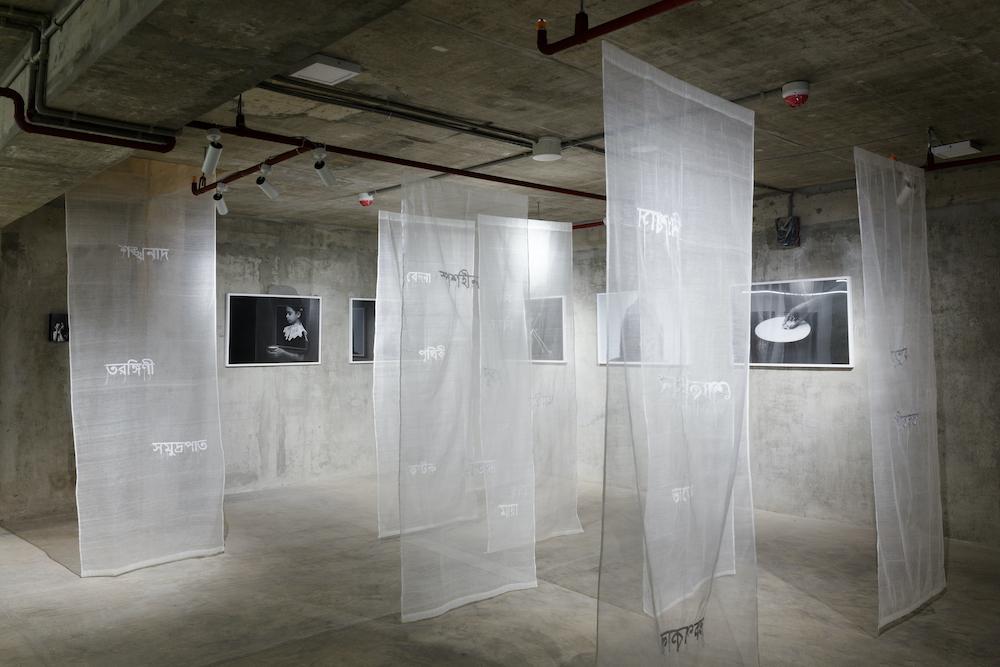Family Threads: Yasmin Jahan Nupur’s Relationship with Practice

Thorny Throat. (Photograph by Manir Mrittik. Dhaka, 2020–21. Time Could Not Be Kept at Bay.)
Yasmin Jahan Nupur is a Bangladeshi artist who investigates the fragile relationship between time and memory. An interdisciplinary artist based in Dhaka, Nupur’s works traverse performance, video, sound, photography, textile, embroidery and drawing to depict varying facets of human relationships—from family to community engagement. She explores socio-political class distinctions, violence, borders, belonging, the status of women and the situatedness of people in diverse societal states. Through her silent yet powerful narratives, Nupur’s works—centred on performance and self-representation—exude a sense of resilience of the body and of time. Describing her process of working akin to creating a personal archive, she impresses upon the intricacies of a place within which intangible forms of displacement exist. These include landscape, architecture, textile and the physical presence of being.
Underlying the multiple narratives of Nupur’s work is the constant link to family. This thread is evident from her early embroidery works (2014–15) that seed from memories of her mother stitching, to her series Home (2019) that references her family’s farm lands lost to construction companies. Recently exhibited at Chobi Mela, Time Could Not Be Kept at Bay (2020–21) is a series born out of a collaboration between her photographer husband, Manir Mrittik, and their daughter, Megh, as a response to the Covid-19 pandemic.

Installation View of Time Could Not Be Kept at Bay at Chobi Mela. (Photograph by Farhad Rahman [Chobi Mela]. Dhaka, 2021.)
Through the mediums of textile, videos and images, Nupur questions the meaning of memory in the context of human relationships and interpersonal states of existence. Time Could Not Be Kept at Bay holds within it elements of hope and time, closely linked to family and artistic practice. A sense of time and timelessness describe the intimate nature of the work as Nupur breaks down the boundaries between art and life. She explores daily activities of cleaning, cooking and caring as meditative actions. Referring to cleaning as associated with hygiene and purity, she develops a closeness to objects such as the loom, the mop and dried flowers around her home.

“Piyach Ful” (Onion Flowers). (Photograph by Manir Mrittik. Dhaka, 2020–21. Time Could Not Be Kept at Bay.)

এক বাটি দুধ (Bowl of Milk). (Photograph by Manir Mrittik. Dhaka, 2020–21. Time Could Not Be Kept at Bay.)
In trying to frame time and create its archive, Nupur began documenting these everyday rituals with the help of her husband. The photographs from Time Could Not Be Kept at Bay are all black-and-white to preserve and suggest this body of work as a timeless archive. Placing herself in some images, and her daughter and objects in others; the staged photographs became an act of performance with careful attention to costumes and props such as plates and balloons. Nupur’s concern with the hardships embedded in social discrepancies spill into the images that serve as an understanding of privilege. The image of the artist’s daughter, Megh, with a bowl of milk and rice is a signifier of her blessings of nourishment and care in contrast to a news piece the artist was responding to—of a young girl succumbing to starvation. The images in this series were planned with the same keenness to details as Nupur’s performances such as Our Own Privet Anthology (2016–ongoing) and Let Me Get You a Nice Cup of Tea (2019).

Let Me Get You a Nice Cup of Tea at the Frieze Art Fair. (Photograph by Becky Costello [Frieze London]. London, 2019.)
Singular phrases extracted from Nupur’s writings—poems and reflections made during the lockdown period of the pandemic—were woven on translucent jamdani screens to accompany the photographs of Time Could Not Be Kept at Bay. The screens were suspended from the ceiling to form a spatial layering that made navigating the work an immersive and performative experience for the viewers. The work integrated layers of the artist’s practice, including performance, embroidery and the image. Speaking about the context of the text accompanying the image, the artist said, “The word may not give you the exact meaning, but it will give you a vocabulary to understand (the image).”

Installation View of Time Could Not Be Kept at Bay at Chobi Mela. (Photograph by Farhad Rahman [Chobi Mela]. Dhaka, 2021.)
The process of viewing this work in relation to Nupur’s larger practice, brought to the fore the conscious elements of presence—of the artist and of the viewer. The artist’s placement of text and image creates a sensory experience that makes the viewer ponder the possible stillness of time.
All works by Yasmin Jahan Nupur. Images courtesy of the artist.




